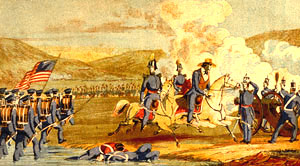
Mexican War
In 1846 the United States went to war with Mexico as a result of a boundary dispute fueled by an American expansionist desire to control the entire North American continent. With an army of fewer than 9,000, a number wholly inadequate to wage war in a foreign country, officials in Washington issued a call for volunteers. When Secretary of War William Marcy requested 2,800 recruits from Tennessee to fill two regiments of infantry and one of cavalry, 30,000 Tennesseans offered their services, thus preserving the reputation of the “Volunteer State.”
Numerous Tennesseans played prominent roles in the conflict, starting with President James K. Polk of Columbia. Sometimes described as the first true commander-in-chief in U.S. history, Polk was actively involved and maintained oversight in the conduct of the two-year struggle. He also unsuccessfully tried to provide sufficient opportunities for Democratic Party faithfuls to achieve fame and glory in Mexico so as to assure a party victory in the 1848 election. Such favoritism caused clashes with Whig generals like Winfield Scott and Zachary Taylor, who won the presidency after the war. The list of important Tennesseans who served in Mexico also includes three future governors: William Trousdale (Democrat, 1849-51); William Campbell (Whig, 1851-53); and William Bate (Democrat, 1882-86). Bate, who later served as a United States senator until his death in 1905, also held the rank of general in the Civil War. Gideon Pillow, Benjamin F. Cheatham, and George Maney also used the battlefields of Mexico as a training ground for their later role as Confederate generals.
In the summer of 1846, state officials employed a lottery system to determine who among the overwhelming number of volunteers would serve and who had to return home. Approximately 1,000 men from Middle Tennessee counties formed the First Tennessee Infantry Regiment commanded by Colonel William Campbell. Volunteers from the western part of the state comprised the Second Tennessee Infantry Regiment commanded by Colonel William T. Haskell, while a contingent of dragoons hailed from East Tennessee.
After joining General Zachary Taylor’s army in June 1846, the First Tennessee became a part of John Quitman’s brigade while the Second Tennessee was assigned to Pillow’s brigade. Illness plagued the army during its stay in northern Mexico that summer, and the First Tennessee was particularly hard hit. While encamped at Camargo, Captain Frank Cheatham, company commander of the Nashville Blues, wrote home to his brother complaining that only about half the regiment was fit for duty. Despite its reduced numbers, the regiment fought admirably at the battle of Monterey in September. At the crucial point of the engagement, it surged forward and assaulted Fort Teneria, a Mexican bastion guarding the city. Afterward one member of the unit described the density of the enemy fire as thick as a handful of thrown peas. First over the walls and into the fort, the regiment won the nickname the “Bloody First.”
Both Tennessee regiments were later transferred to General Winfield Scott’s army and saw action in the Mexico City Campaign in 1847. In this often overlooked but brilliant campaign, Scott landed an army of 10,000 at Veracruz in March and, after a series of marches and battles, succeeded in capturing the Mexican capital in September. Remnants of both regiments fought a small engagement at Medeline Bridge near Veracruz on March 25, but their most notable involvement came the following month.
Near the village of Cerro Gordo, a Mexican army under Santa Anna held a fortified position overlooking a mountain pass that the Americans had to traverse on their march inland. Rather than assault the enemy stronghold, Scott opted to swing the bulk of his army around and assail the Mexicans in flank and rear. To distract the enemy, however, Scott ordered Pillow, who commanded four regiments of volunteers, including the First and Second Tennessee, to advance and demonstrate in the enemy’s front. Despite Pillow’s mismanagement of his portion of the battle plan, the flank attack succeeded, and the Mexican army fled further inland. Santa Anna later characterized Cerro Gordo as the most significant American victory of the war.
When their twelve-month enlistments expired in the summer of 1847, most volunteers, including the First and Second Tennessee, opted to return home. They were discharged and allowed to leave the army prior to the fall of Mexico City, but some of them returned later in the campaign, having joined new regiments raised to replace the old. Pillow returned as a division commander in time to play a controversial role in the battles that occurred on the outskirts of the enemy capital. Later he exaggerated the significance of his part in the battle of Contreras, and as a result was court-martialed for violating army regulations. (He had written about his exploits in a letter that was published in American newspapers–a breach of the army’s code of conduct.) The court exonerated him–many believe because of his friendship with President Polk. The Third and Fourth Tennessee Regiments were raised that summer and fall, but both arrived too late to participate in the fighting around the enemy capital. They were used rather to garrison towns and guard supply lines while officials negotiated the Treaty of Guadalupe Hildago that ended the conflict.



